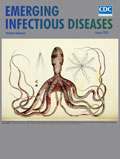
Volume 26, Number 8—August 2020
Letter
Intact Mycobacterium leprae Isolated from Placenta of a Pregnant Woman, China
On This Page
Downloads
Article Metrics
To the Editor: Chen et al. (1) reported intact Mycobacterium leprae in homogenate of placenta of a pregnant woman with untreated histoid leproma, highlighting the effectiveness of the placental barrier in stopping vertical transmission of leprosy (Hansen disease). However, reports in the published literature indicate that this claim is not absolutely correct.
Several early studies provided evidence of transplacental transmission of M. leprae; these studies revealed M. leprae in umbilical cords (25/104) (2) and cord blood (10/12) (3) of neonates born to mothers with leprosy, as well as in the placentae (57/104 and 9/12) (2,3) of those mothers (2,3). Furthermore, transplacental infection with M. leprae has been supported by an increased concentration of IgA in cord blood (4) and M. leprae IgA and IgM in cord serum (5) of babies of mothers with leprosy. These observations indicate that in some mothers with leprosy, whole M. leprae, its antigens, or both can cross the placenta, possibly inducing the fetal immune system to produce antibodies against M. leprae antigens. Therefore, we believe that vertical transmission of M. leprae is a complex, uncommon, and multifactorial event that might depend on the presence of M. leprae in maternal blood, maternal and fetal immune responses, fetal gestational age at infection, and other placental factors.
Consequently, the claim of Chen et al. (1) needs to be read with attention to the limitations of the underlying data and might not be generalizable to all mothers with leprosy. Further studies are needed to clarify the mechanisms of transplacental transmission of leprosy. The follow-up care of newborns of mothers with leprosy is necessary for early detection of the disease and to ensure appropriate general healthcare, especially considering that babies of mothers with leprosy have lower fetoplacental weights, slower growth, more fatal infections, and higher rates of infant mortality than those of mothers without leprosy.
References
- Chen Z, Kuang Y, Jiang H, Zhang W, Shi Y, Chokkakula S, et al. Intact Mycobacterium leprae isolated from placenta of a pregnant woman, China. Emerg Infect Dis. 2019;25:1604–7.
- Pineda EV. The presence of Mycobacterium leprae in the placenta and umbilical cord. J Philipp Med Assoc. 1928;VIII:67–70.
- Sugai T, Monobe J. Uber histologische befunde in der placenta tuberkulose und leprakranker. zentralblatt für bakteriol-ogie, Parasitenkunde. Infektionskrankheiten und Hygiene. 1913;13:262.
- Melsom R, Duncan ME, Bjune G. Immunoglobulin concentration in mothers with leprosy and in healthy controls and their babies at the time of birth. Lepr Rev. 1980;51:19–28.
- Melsom R, Harboe M, Duncan ME, Bergsvik H. IgA and IgM antibodies against Mycobacterium leprae in cord sera and in patients with leprosy: an indicator of intrauterine infection in leprosy. Scand J Immunol. 1981;14:343–52.
Original Publication Date: June 25, 2020






















.png)











No hay comentarios:
Publicar un comentario